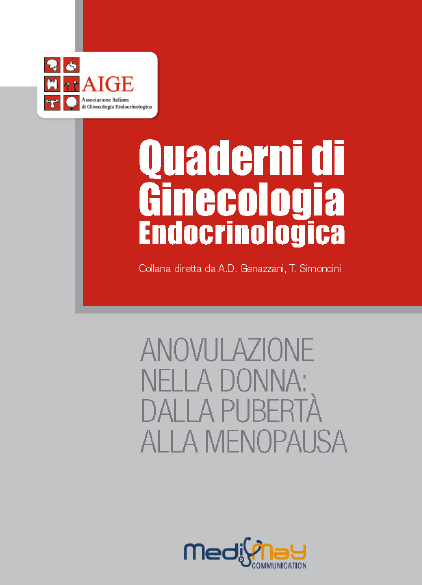-
Daniela Romualdi, Maddalena Giuliani, Francesca Cristello, Anna Maria Fulghesu, Luigi Selvaggi, Antonio Lanzone, Maurizio Guido
Metformin effects on ovarian ultrasound appearance and steroidogenic function in normal-weight normoinsulinemic women with polycystic ovary syndrome: a randomized double-blind placebo-controlled clinical trial
Fertil Steril 2010, 93: 2095-2464
Abstract
Objective To investigate metformin effects on the endocrine-metabolic parameters and ovarian morphology in normoinsulinemic women with polycystic ovary syndrome (PCOS).
Design Randomized double-blind study.
Setting Operative Division of Endocrinological Gynecology, Università Cattolica del Sacro Cuore. Patient(s) Twenty-eight normal-weight normoinsulinemic PCOS women.
Intervention(s) Patients were randomized to receive metformin 500 mg twice a day (group A, 15 subjects) or placebo (group B, 13 subjects) for 6 months. Ultrasonographic pelvic exams, hormonal and lipid features, and oral glucose tolerance test were performed at baseline and after 3 and 6 months of treatment.
Main Outcome Measure(s) Hormonal and glycoinsulinemic assessment, ovarian ultrasound appearance.
Result(s) Glycoinsulinemic assessment remained unvaried in both groups. About 70% of patients in group A experienced a restoration of menstrual cyclicity. Metformin significantly decreased testosterone levels at 3 and 6 months) and 17-hydroxyprogesterone levels at 6 months, and improved hirsutism score at 6 months. No clinical or hormonal modifications occurred in group B. Metformin, but not placebo, reduced ovarian volume and stromal/total area ratio at 3 and 6 months.
Conclusion(s) Metformin seems to improve the menstrual pattern and ultrasonographic ovarian features in normoinsulinemic PCOS women. These effects seem to be, at least in part, independent of the insulin-lowering properties of the drug.
-
Roy Mashiach, Ami Amit, Joseph Hasson, Sagi Amzalzg, Beni Almog, Dalit Ben-Yosef, Joseph B. Lessing, Rona Limor, Foad Azem
Follicular fluid levels of anti-Mullerian hormone as a predictor of oocyte maturation, fertilization rate, and embryonic development in patients with polycystic ovary syndrome
Fertil Steril 2010, 93: 2299-2302
Abstract
ObjectiveTo test whether the follicular fluid (FF) concentration of anti-Mullerian hormone (AMH) is associated with oocyte maturation, fertilization rate, and embryonic development in patients with polycystic ovary syndrome (PCOS) undergoing IVF. Design Prospective. Setting Academic assisted reproductive technology program.
Patient(s) Twenty-two samples of FF from 11 patients with PCOS who underwent IVF/ET were analyzed for AMH levels (group A). Twelve women with normal ovulatory cycles served as a control group (group B). The oocytes and preembryos were closely followed until ET.
Method(s) FF was obtained at oocyte retrieval for IVF/intracytoplasmic sperm injection. AMH levels were studied using immunoenzymometric assay. Intervention(s) None.
Main Outcome Measure(s) FF, AMH levels, oocyte maturation, fertility rate, and embryonic cleavage rate. Result(s) The mean FF AMH level was 57.3 ± 79.5 pmol/mL in group A, compared with 70 ± 120.14 pmol/mL in group B. In group A, the mean AMH level of good-quality embryos was 37.4 ± 23.4 pmol/mL, compared with 61.9 ± 102 pmol/mL in a the poor-quality subgroup. No significant correlation was observed between FF AMH levels and oocyte maturation, fertilization, or cleavage rate.
Conclusion(s) This study suggests that there is an association between FF AMH levels and the quality of embryos in patients with PCOS. However, owing to large variance and the number of participants, no statistical significance was reached. The degree of maturation of retrieved oocytes, as well as the success of fertilization, was not found to correlate with FF AMH.
-
SM Bhattacharya
Insulin resistance and overweight-obese women with polycystic ovary syndrome
Gynecological Endocrinology, 2010, 26: 344-347
Abstract
Aim. To estimate (1) the prevalence of insulin resistance (IR) by fasting glucose: insulin ratio (G:I) (G:I ≤ 4.5) in overweight-obese polycystic ovary syndrome (PCOS) women, (2) to compare the clinical and biochemical parameters between insulin-resistant and insulin-sensitive groups.
Materials and Methods. Eighty-one overweight-obese PCOS women (body mass index (BMI) ≥ 23 kg/m2) were studied. PCOS was diagnosed as per the Rotterdam 2003 criteria. BMI, abdominal circumference (AC), hirsutism (Ferriman Gallway score ≥6), presence of acne and acanthosis nigricans (AN) were noted in each case. Serum testosterone, sex hormone binding globulin (SHBG), fasting plasma glucose and insulin levels were measured.
Results. 23.5% women were found to have IR. There were no differences in age, frequency of hirsutism, acne, serum testosterone and fasting glucose levels between insulin-resistant and insulin-sensitive women. However, there were significant differences in BMI, AC, frequency of AN, SHBG levels, fasting insulin levels and FAI between the two groups.
Conclusion. PCOS women with IR are more obese; they have more upper body adiposity and AN. They are more hyperandrogenic. Simple clinical parameters will help to suspect IR in PCOS women.
-
Orawan Kiriwat , Somsin Petyim
The effects of transdermal contraception on lipid profiles, carbohydrate metabolism and coagulogram in Thai women
Gynecological Endocrinology, 2010, 26: 361-365.
Abstract
Objective. To evaluate the effects of the contraceptive patch on lipid profiles, carbohydrate metabolism and coagulogram in Thai women.
Methods. Fifty healthy Thai women were assigned to use contraceptive patches. Blood chemistries test including liver function test, lipid profiles and coagulogram were evaluated at baseline, cycles 3 and 6.
Results. Total cholesterol, triglyceride and HDL were significantly increased, whereas LDL was slightly decreased. The ratio of total cholesterol/HDL and LDL/HDL significantly decreased when applying the patch. After discontinued use of contraceptive patch, the women whose blood tests present hypercholesterol during patch use showed a continuous decrease in blood results of total cholesterol level over 3 months. Moreover, mean fasting glucose, SGOT, SGPT and alkaline phosphate were decreased. No woman suffering from VTE in this study.
Conclusions. The use of contraceptive patch does not exert a negative effect on carbohydrate metabolism, lipid profile, liver function test and blood coagulogram. However, further studies are required to elucidate the effect of the contraceptive on the patch user in long term.
-
Robert A. Wild, Enrico Carmina, Evanthia Diamanti-Kandarakis, Anuja Dokras, Hector F. Escobar-Morreale, Walter Futterweit, Rogerio Lobo, Robert J. Norman, Evelyn Talbott, Daniel A. Dumesic
Assessment of Cardiovascular Risk and Prevention of Cardiovascular Disease in Women with the Polycystic Ovary Syndrome: A Consensus Statement by the Androgen Excess and Polycystic Ovary Syndrome (AE-PCOS) Society
J Clin Endocrinol Metab 95: 2038–2049, 2010
Abstract
Objective: Women with polycystic ovary syndrome (PCOS) often have cardiovascular disease (CVD) risk factors. The Androgen Excess and Polycystic Ovary Syndrome (AE-PCOS) Society created a panel to provide evidence-based reviews of studies assessing PCOS-CVD risk relationships and to develop guidelines for preventing CVD.
Participants: An expert panel in PCOS and CVD reviewed literature and presented recommendations.
Evidence: Only studies comparing PCOS with control patients were included. All electronic databases were searched; reviews included individual studies/databases, systematic reviews, abstracts, and expert data. Articles were excluded if other hyperandrogenic disorders were not excluded, PCOS diagnosis was unclear, controls were not described, or methodology precluded evaluation. Inclusion/exclusion criteria were confirmed by at least two reviewers and arbitrated by a third.
Consensus Process: Systematic reviews of CVD risk factors were compiled and submitted for approval to the AE-PCOS Society Board.
Conclusions: Women with PCOS with obesity, cigarette smoking, dyslipidemia, hypertension, impaired glucose tolerance, and subclinical vascular disease are at risk, whereas those with metabolic syndrome and/or type 2 diabetes mellitus are at high risk for CVD. Body mass index, waist circumference, serum lipid/glucose, and blood pressure determinations are recommended for all women with PCOS, as is oral glucose tolerance testing in those with obesity, advanced age, personal history of gestational diabetes, or family history of type 2 diabetes mellitus. Mood disorder assessment is suggested in all PCOS patients. Lifestyle management is recommended for primary CVD prevention, targeting low-density and non-high-density lipoprotein cholesterol and adding insulin-sensitizing and other drugs if dyslipidemia or other risk factors persist.
-
Robert B. Gibbs
Estrogen Therapy and Cognition: A Review of the Cholinergic Hypothesis
Endocrine Reviews 31: 224–253, 2010
Abstract
The pros and cons of estrogen therapy for use in postmenopausal women continue to be a major topic of debate in women’s health. Much of this debate focuses on the potential benefits vs. harm of estrogen therapy on the brain and the risks for cognitive impairment associated with aging and Alzheimer’s disease. Many animal and human studies suggest that estrogens can have significant beneficial effects on brain aging and cognition and reduce the risk of Alzheimer’s-related dementia; however, others disagree. Important discoveries have been made, and hypotheses have emerged that may explain some of the inconsistencies. This review focuses on the cholinergic hypothesis, specifically on evidence that beneficial effects of estrogens on brain aging and cognition are related to interactions with cholinergic projections emanating from the basal forebrain. These cholinergic projections play an important role in learning and attentional processes, and their function is known to decline with advanced age and in association with Alzheimer’s disease. Evidence suggests that many of the effects of estrogensonneuronal plasticity and function and cognitive performance are related to or rely upon interactions with these cholinergic projections; however, studies also suggest that the effectiveness of estrogen therapy decreases with age and time after loss of ovarian function. We propose a model in which deficits in basal forebrain cholinergic function contribute to age-related changes in the response to estrogen therapy. Based on this model, we propose that cholinergic-enhancing drugs, used in combination with an appropriate estrogencontaining drug regimen, may be a viable therapeutic strategy for use in older postmenopausal women with early evidence of mild cognitive decline.
-
James A. Simon
Are All Bisphosphonates the Same? Potential Reasons for Clinical Differences: A Perspective
Journal of Women’s Health 2010, 19: 719-727
Abstract
Bisphosphonates are first-line treatment for postmenopausal osteoporosis and women with low bone mass and risk factors for fracture. These agents are often perceived as having equivalent effectiveness and safety and are even used interchangeably by some practitioners. Research suggests, however, that differences between them are meaningful to the patient and clinician. Data from randomized controlled trials and observational database studies have demonstrated variations between bisphosphonates in the scope of fracture protection, such as vertebral and nonvertebral, as well as the speed of onset of this antifracture effect. It has been proposed that unique properties of each compound related to their mechanisms of action could explain, at least in part, differences observed in clinical outcomes. Although the bisphosphonates share a similar core structure, they also contain two side chains or groups, R1 and R2, attached to the central carbon atom. All bisphosphonates approved by the FDA for postmenopausal osteoporosis contain a hydroxyl side group at position R1, increasing their binding to bone and distinguishing them from earlier bisphosphonates not approved for this clinical use. Differences in the physicochemical and biological properties of the approved bisphosphonates are due to differences in the R2 side group. The presence of nitrogen and its orientation within the R2 side chain can influence each bisphosphonate’s overall potency. For the physician to optimally determine the bisphosphonate that best suits an individual patient, it is important that they are aware of the differences between them.
-
Massimo Tonacchera, Aldo Pinchera, Paolo Vitti
Assessment of nodular goitre
Best Pract & Res Clin Endocrinol Metab 2010, 24: 51–61
Abstract
Nodular goitres are enlargements of the thyroid gland. In the absence of thyroid dysfunction, autoimmune thyroid disease, thyroiditis and thyroid malignancy, they constitute an entity described as non-toxic nodular goitre, which occurs both endemically and sporadically. In the early phase of goitrogenesis, goitres are diffuse and, with time, such goitres tend to become nodular. Concomitantly, thyroid function often becomes autonomous, and therefore the patients gradually develop hyperthyroidism. Some non-toxic goitre patients have no symptoms at all, or just complaints of cosmetic disfigurement. In the diagnostic evaluation protocol, neck palpation and several imaging methods are available: ultrasonography (US), the new developed US elastography, scintigraphy, computed tomography (CT) scan and magnetic resonance imaging (MRI). Fine-needle aspiration biopsy (FNAB) provides the most direct and specific information about a thyroid nodule. Recently, a combination of cytology and molecular testing has shown significant improvement in the diagnostic accuracy and allowed for better prediction of malignancy in thyroid nodular disease.
-
Artini P. G., Di Berardino O. M., Simi G., Papini F., Ruggiero M., Monteleone P., Cela V.
Best methods for identification and treatment of PCOS
Minerva Ginecologica 2010, 62:33-48
Abstract
The polycystic ovarian syndrome (PCOS) includes a wide spectrum of clinical symptoms and signs. Three different diagnostic classifications have been proposed to define this disease. The first one, published in 1990, known as the “NIH criteria” requires the simultaneous presence of hyperandrogenism and menstrual dysfunction in order to diagnose PCOS. Later on, in 2003, an expert panel met in Rotterdam and added to the previous criteria the presence of polycystic ovarian morphology detected by transvaginal ultrasonography. The later classification broadened the spectrum of PCOS and also included women with oligomenorrhea and PCO without hyperandrogenism or hyperandrogenism and PCO without menstrual dysfunction. Finally, the Androgen Excess Society, published in 2006 new diagnostic criteria which required the presence of clinical or biochemical hyperandrogenism, with either PCO or menstrual dysfunction to diagnose PCOS. This review focuses on the diagnostic techniques and methods of treatment for PCOS patients. Special attention is given to the role of insulin resistance and the potential utility of insulin sensitizers in management of the syndrome. The benefit and utmost importance of lifestyle modification for the long-term health of these women is stressed as well. It is hoped that some clarity in this regard will allow more women to not only be diagnosed and managed properly for their presenting symptoms (hirsutism, irregular menses, etc.), but also to be educated and managed for the continuing health risk of insulin resistance throughout their lives.
-
Wessel M. A. van Leeuwen, Christer Hublin, Mikael Sallinen, Mikko Härmä, Ari Hirvonen, Tarja Porkka-Heiskanen
Prolonged Sleep Restriction Affects Glucose Metabolism in Healthy Young Men
Int J Endocrinol 2010, Article ID 108641
Abstract
This study identifies the effects of sleep restriction and subsequent recovery sleep on glucose homeostasis, serum leptin levels, and feelings of subjective satiety. Twenty-three healthy young men were allocated to a control group (CON) or an experimental (EXP) group. After two nights of 8 h in bed (baseline, BL), EXP spent 4 h in bed for five days (sleep restriction, SR), followed by two nights of 8 h (recovery, REC). CON spent 8 h in bed throughout the study. Blood samples were taken after the BL, SR, and REC period. In EXP, insulin and insulin-to-glucose ratio increased after SR. IGF-1 levels increased after REC. Leptin levels were elevated after both SR and REC; subjective satiety remained unaffected. No changes were observed in CON. The observed increase of serum IGF-1 and insulin-to-glucose ratio indicates that sleep restriction may result in an increased risk to develop type 2 diabetes.






